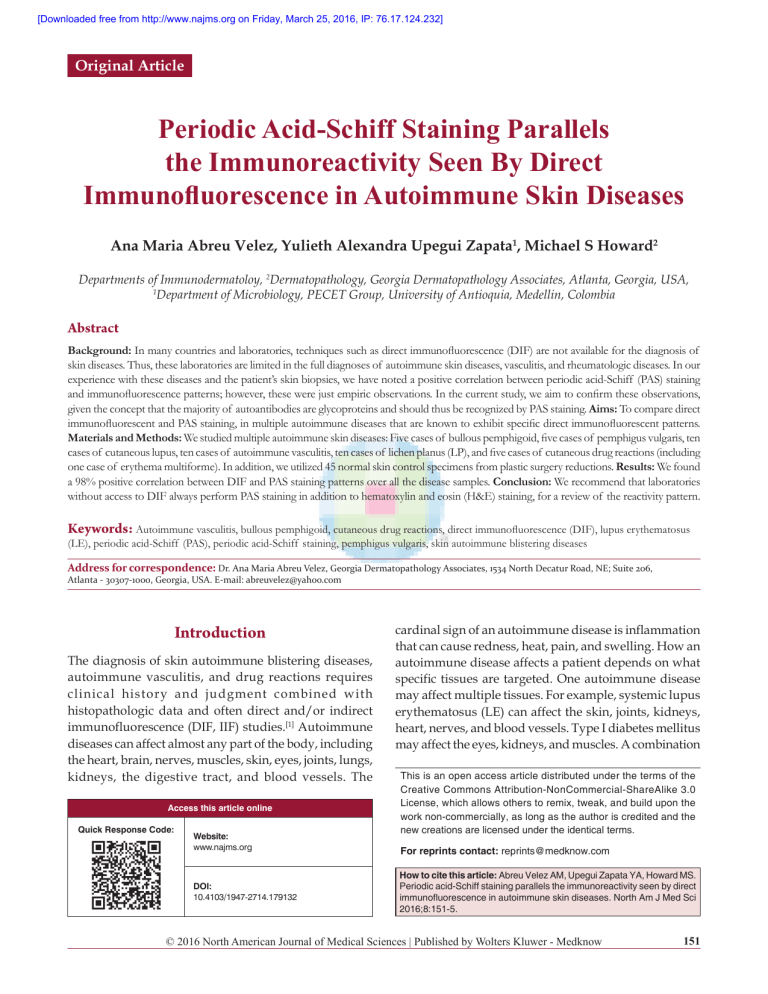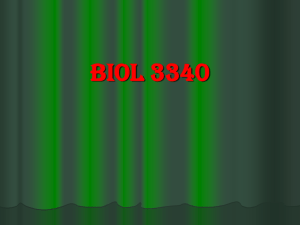PAS versus DIF
advertisement

[Downloaded free from http://www.najms.org on Friday, March 25, 2016, IP: 76.17.124.232] Original Article Periodic Acid-Schiff Staining Parallels the Immunoreactivity Seen By Direct Immunofluorescence in Autoimmune Skin Diseases Ana Maria Abreu Velez, Yulieth Alexandra Upegui Zapata1, Michael S Howard2 Departments of Immunodermatoloy, 2Dermatopathology, Georgia Dermatopathology Associates, Atlanta, Georgia, USA, 1 Department of Microbiology, PECET Group, University of Antioquia, Medellin, Colombia Abstract Background: In many countries and laboratories, techniques such as direct immunofluorescence (DIF) are not available for the diagnosis of skin diseases. Thus, these laboratories are limited in the full diagnoses of autoimmune skin diseases, vasculitis, and rheumatologic diseases. In our experience with these diseases and the patient’s skin biopsies, we have noted a positive correlation between periodic acid-Schiff (PAS) staining and immunofluorescence patterns; however, these were just empiric observations. In the current study, we aim to confirm these observations, given the concept that the majority of autoantibodies are glycoproteins and should thus be recognized by PAS staining. Aims: To compare direct immunofluorescent and PAS staining, in multiple autoimmune diseases that are known to exhibit specific direct immunofluorescent patterns. Materials and Methods: We studied multiple autoimmune skin diseases: Five cases of bullous pemphigoid, five cases of pemphigus vulgaris, ten cases of cutaneous lupus, ten cases of autoimmune vasculitis, ten cases of lichen planus (LP), and five cases of cutaneous drug reactions (including one case of erythema multiforme). In addition, we utilized 45 normal skin control specimens from plastic surgery reductions. Results: We found a 98% positive correlation between DIF and PAS staining patterns over all the disease samples. Conclusion: We recommend that laboratories without access to DIF always perform PAS staining in addition to hematoxylin and eosin (H&E) staining, for a review of the reactivity pattern. Keywords: Autoimmune vasculitis, bullous pemphigoid, cutaneous drug reactions, direct immunofluorescence (DIF), lupus erythematosus (LE), periodic acid-Schiff (PAS), periodic acid-Schiff staining, pemphigus vulgaris, skin autoimmune blistering diseases Address for correspondence: Dr. Ana Maria Abreu Velez, Georgia Dermatopathology Associates, 1534 North Decatur Road, NE; Suite 206, Atlanta - 30307-1000, Georgia, USA. E-mail: abreuvelez@yahoo.com Introduction The diagnosis of skin autoimmune blistering diseases, autoimmune vasculitis, and drug reactions requires clinical history and judgment combined with histopathologic data and often direct and/or indirect immunofluorescence (DIF, IIF) studies.[1] Autoimmune diseases can affect almost any part of the body, including the heart, brain, nerves, muscles, skin, eyes, joints, lungs, kidneys, the digestive tract, and blood vessels. The Access this article online Quick Response Code: Website: www.najms.org DOI: 10.4103/1947-2714.179132 cardinal sign of an autoimmune disease is inflammation that can cause redness, heat, pain, and swelling. How an autoimmune disease affects a patient depends on what specific tissues are targeted. One autoimmune disease may affect multiple tissues. For example, systemic lupus erythematosus (LE) can affect the skin, joints, kidneys, heart, nerves, and blood vessels. Type I diabetes mellitus may affect the eyes, kidneys, and muscles. A combination This is an open access article distributed under the terms of the Creative Commons Attribution-NonCommercial-ShareAlike 3.0 License, which allows others to remix, tweak, and build upon the work non-commercially, as long as the author is credited and the new creations are licensed under the identical terms. For reprints contact: reprints@medknow.com How to cite this article: Abreu Velez AM, Upegui Zapata YA, Howard MS. Periodic acid-Schiff staining parallels the immunoreactivity seen by direct immunofluorescence in autoimmune skin diseases. North Am J Med Sci 2016;8:151-5. © 2016 North American Journal of Medical Sciences | Published by Wolters Kluwer - Medknow 151 [Downloaded free from http://www.najms.org on Friday, March 25, 2016, IP: 76.17.124.232] Velez, et al.: PAS staining parallels the immunoreactivity seen by DIF in autoimmune skin diseases of factors is probably causative in most autoimmune diseases, including genetic as well as environmental factors.[2,3] Periodic acid-Schiff (PAS) is a staining method used to detect polysaccharides, manifested as glycogen, glycoproteins, glycolipids, and mucin in tissues.[4,5] In general, the PAS stain is recommended to be performed on tissues fixed with 10% neutral buffered formalin.[4,5] Based on the fact that many autoantibodies and complement are indeed glycoproteins,[4,5] we aimed to determine if a correlation of patterns was present between PAS and DIF staining in multiple autoimmune skin diseases. Materials and Methods We utilized archival biopsies. A case-control study design was used to compare DIF positivity versus PAS positivity. Both DIF and PAS samples were taken from the same patient and the skin area at the same time. All samples were reviewed via H&E and PAS staining; our staining was performed as previously described.[6] In brief, we studied 45 archival skin biopsies; each biopsy was independently diagnosed by one board-certified dermatopathologist and one immunodermatologist, both in the USA. All biopsies were initially fixed in 10% buffered formalin, embedded in paraffin, and cut at 4 micron thicknesses. Our study included only the lesions that had classic histologic features of each disease. The Georgia Dermatopathology Associates Research Ethics Committee approved the study. A signed consent was obtained from the patients, and no patient identifiers were published. We studied ten cases of pemphigus vulgaris, five of bullous pemphigoid, ten cases of LE, ten of autoimmune vasculitis, ten cases of lichen planus (LP), and five cases of cutaneous drug reactions (including one of erythema multiforme). We utilized 45 normal skin control specimens from reduction plastic surgeries. Our pathologic cases were diagnosed by correlating clinical, epidemiologic, histopathologic, and immunologic methods; these methods included immunoblotting and enzyme-linked immunosorbent assay (ELISA) testing in selected cases. Our DIF was additionally performed as previously described.[4] In brief, for DIF, we obtained the biopsies in Michel’s transport medium at room temperature, and stored at 4°C until it was cut. Before cutting, we washed the biopsies in Michel’s washing medium, and/or in phosphate-buffered saline (PBS) (pH 7.2) for 10-15 min. For frozen sections, the tissue was embedded in optimum cutting temperature (OCT) medium and sections of 4-5 micron thickness were cut. We used three sections on each slide, employing a pap pen to help avoid spreading one antibody into the other. We utilized fluorescein isothiocyanate (FITC)-conjugated 152 rabbit antisera to human immunoglobulin (Ig)G, IgA, IgM, Complement/C1q, Complement/C3, fibrinogen, and albumin. Specifically, FITC-conjugated rabbit antihuman IgG (1:25), IgA (1:25), and IgM (1:25) were used. For the antihuman fibrinogen and anti-albumin antibodies, we used 1:40 dilutions. The preceding antisera were purchased from Dako (Carpinteria, California, USA). In addition, we utilized FITCconjugated goat antihuman IgE, (Kent Laboratories, Bellingham, Washington, USA) and antihuman FITCconjugated IgD antibodies (Southern Biotechnology, Birmingham, Alabama). The slides were counterstained with 4’, 6-diamidino-2-phenylindole (DAPI) (Pierce, Rockford, Illinois, USA), washed, coverslipped, and dried overnight at 4°C. Finally, we additionally used rhodamine-conjugated Ulex Europaeus Agglutinin 1 (Ulex) (Vector Laboratories, Burlingame, California, USA). Statistical analysis We stained 45 normal controls from plastic surgery reductions. We compared the controls with the pathologic skin conditions mentioned above. Two observers, each blinded to the sample identities, read both the DIF and the PAS stains. Results The 45 normal skin biopsies did not have any significant reactivity pattern. In 5/45 skin biopsies, some reinforcements were seen around eccrine sweat glands and their ducts. In 5/5 lupus cases, all of them were positive along the primary basement membrane zone (BMZ), as well as along eccrine gland BMZs, and sebaceous gland BMZs. The PAS findings were similar to those of the DIF [see Table 1]. Of interest, colloid bodies have been noted in lupus as well as LP cases by both methods. In regard to the samples with LP, 9/10 were positive by PAS in a linear pattern, and by DIF 10/10 were positive. In the cases of vasculitis, we noted positivity Table 1: Comparison between PAS and DIF reactivity Diagnosis and number of cases PAS DIF Positive area Skin lupus Bullous pemphigoid Pemphigus 5/5 5/5 5/5 5/5 Basement membrane zone. Basement membrane zone. 5/5 5/5 Vasculitis 9/10 10/10 Drug eruptions, including erythema multiforme Lichen planus 5/5 5/5 Intercellular staining between keratinocytes Superficial and some intermediate/or deep skin vessels. Superficial skin vessels sweat glands 9/10 10/10 North American Journal of Medical Sciences | Mar 2016 | Volume 8 | Issue 3 | Basement membrane zone [Downloaded free from http://www.najms.org on Friday, March 25, 2016, IP: 76.17.124.232] Velez, et al.: PAS staining parallels the immunoreactivity seen by DIF in autoimmune skin diseases to the superficial, the intermediate and/or deep vessels of the dermis; in each case, the level of the positivity in the vessels was the same with both techniques (with the exception of one case that was negative, or very weak positive by PAS and was positive by DIF [see Table 1]). In regard to the cases of erythema multiforme, we additionally found a correlation between the positivity and the anatomic level of the reactivity, with both PAS and DIF. The most severe cases diagnosed as erythema multiforme on H&E showed the strongest reactivity to the vessels; the majority were superficial, the intermediate depth vessels were second, and deep vessels the last. In the cases of severe drug reactions, the PAS failed to show staining; staining was noted mostly with FITC conjugated antifibrinogen on DIF, against multiple cell junctions in the epidermis and cell junctions of an unknown nature in the dermis. In the cases of pemphigus and pemphigoid, both techniques (PAS and DIF) showed similar results and staining patterns [see Table 1]. Table 1 shows a case-control study design was used to compare DIF positivity versus PAS stain positively. Our interrater reliability (agreement or concordance among the raters) was 95%. The score indicates how much consensus was found between the observers. The main problem we encountered in this context was that in a few cases, the PAS staining and the DIF staining were fainter than in other cases. Because the comparison Figure 1: (a-c) A representative case of erythema multiforme. (a) H&E staining, showing edematous, large eccrine sweat glands (black arrow) (200×) (b) DIF, using FITC conjugated antihuman fibrinogen; note positive staining around the same glands (green staining; white arrow) (c) PAS stain, showing mild positivity against the same glands (purple staining; black arrow). (d-f) A representative example of a drug eruption. (d) H and E staining showing edematous eccrine duct (black arrow) (400×) (e) PAS stain, showing positivity against a nearby eccrine gland glands (purple/red staining; black arrow) (f) DIF using FITC conjugated antihuman Complement/C3, and showing positive staining around the sweat glands (green staining). The nuclei of the cells were counterstained with DAPI in blue, and the blood vessels around the sweat gland stained with Ulex in red was between DIF and PAS staining, autoantibody titers were not reviewed. The positive PAS reactivity was determined as positive or negative. The positivity of the other dermatosis on DIF was read as positive of negativity as well. In Figures 1-3, we show specific examples of the disease specimens we examined and the results of the H&E, PAS, and DIF staining. Discussion The detection of immunoglobulin or complement deposits has a diverse diagnostic value for different inflammatory and autoimmune dermatoses.[2,3] While for autoimmune blistering diseases, the detection of tissuebound autoantibodies are essential diagnostic criteria, revealing deposits of immunoreactants is helpful, but not strictly required for diagnosis of LE and LP[2,3] Antibodies and autoantibodies are immune system proteins called immunoglobulins, and they are rich in polysaccharides. [7-9] In addition, autoimmune diseases often attack carbohydrate epitopes in the body. Immunoglobulins are primarily glycoprotein molecules produced by B lymphocytes and plasma Figure 2: (a-c) A case of a vasculitis. (a) H and E staining, showing an upper dermal perivascular infiltrate (black arrows) (100×) (b) Positive staining with PAS around the same vessels as in a; the observed staining was not exclusively on neutrophils (purple staining; black arrows) (100×) (c) DIF, showing positive staining with fibrinogen FITC conjugated, against the same vessels (green staining; red arrow) (400×). The identity of the blood vessels was confirmed using CD31 immunohistochemistry. (d-f) A case of cutaneous lupus. (d) H and E staining shows damage to the basement membrane zone at the area of a hair follicle, and the inflammatory infiltrate (black arrow) (100×) (e) Shows a highlight of d, at the basement membrane zone (black arrow) (200×) (f) Shows DIF positive staining at the basement membrane zone of the sweat glands, using FITC conjugated anti-human IgM (green staining; white arrow). The nuclei of epidermal keratinocytes were counterstained with DAPI (light blue) North American Journal of Medical Sciences | Mar 2016 | Volume 8 | Issue 3 | 153 [Downloaded free from http://www.najms.org on Friday, March 25, 2016, IP: 76.17.124.232] Velez, et al.: PAS staining parallels the immunoreactivity seen by DIF in autoimmune skin diseases signature. The signature would be characterized by site-specific relative protrusions of individual glycan structures on immune cells and extracellular proteins, especially, site-specific glycosylation patterns of individual Ig classes and subclasses.[10,11] Further studies could record a scale of positivity of PAS (most pathologists simply report positive or negative staining), and additionally report autoantibody titers; these attempts are beyond the scope of our pilot study. Additional studies could additionally determine the positivity of PAS in other dermatoses, and compare these with DIF; these disorders could include autoimmune diseases in the oral mucosa; but we had no access to oral specimens for our study. Figure 3: (a-c) A case of bullous pemphigoid. (a) Shows a subepidermal blister, with a few eosinophils near the base (black arrow) (200×) (b) Shows PAS positive staining at the basement membrane zone (light red staining; black arrow) (200×) (c) DIF positive staining, showing linear staining of FITC conjugated antihuman Complement/C3 at the basement membrane zone (green staining; white arrow). (d-f) A case of pemphigus vulgaris. (d) Classic intraepidermal blister (black arrow) (100×) (e) PAS staining, showing some intercellular staining between keratinocytes (purple staining; black arrow) (400×) (f) DIF, showing intercellular staining of IgG FITC conjugated in a “fish scale” pattern between epidermal keratinocytes (light green staining; white arrow) (200×) cells in response to an immunogen. Our pilot study showed good sensitivity, specificity, and positive and negative predictive values when comparing both methods. We speculate that the correlation of staining positivity between PAS and DIF is due to the fact that reactive disease areas have stronger concentrations of polysaccharides, monosaccharides, and carbohydrates. Many reactive disease areas attract complement as well. Protein-carbohydrate interactions play critical roles in both the activation and regulation of complement factors. Of interest, we were able to see the colloid bodies using both PAS and DIF. Colloid bodies are eosinophilic hyaline ovoid bodies that are often found in the subepidermal papillary regions or sometimes in the epidermis. They are usually seen in LP and LE. We speculate that these bodies may contain polysaccharides. One problem observed in some samples was that the positive staining of PAS as well as DIF was very subtle. Thus, it was sometimes difficult to be certain as to which specific structures were exhibiting positive staining. Because our comparison was between DIF and PAS staining patterns, autoantibody titers were not studied. A recent review[10,11] postulated “The Altered Glycan Theory of Autoimmunity”; this theory suggests that each autoimmune disease may have an exclusive glycan 154 Conclusion We conclude that laboratories lacking DIF, review a PAS slide in suspected cases of cutaneous autoimmune disorders. The PAS data, combined with a clinical history and H&E staining, may suggest an autoimmune skin disease diagnosis. Additionally, confirmatory DIF data would still be warranted, if clinically indicated. Financial support and sponsorship Georgia Dermatopathology Associates (MSH, AMAV). Conflicts of interest There are no conflicts of interest. References 1. 2. 3. 4. 5. 6. 7. Beutner EH, Jordon RE. Demonstration of skin antibodies in sera of pemphigus vulgaris patients by indirect immunofluorescent staining. Proc Soc Exp Biol Med 1964; 117:505-10. Otten JV, Hashimoto T, Hertl M, Payne AS, Sitaru C. Molecular diagnosis in autoimmune skin blistering conditions. Curr Mol Med 2014;14:69-95. Chiorean R, Mahler M, Sitaru C. Molecular diagnosis of autoimmune skin diseases. Rom J Morphol Embryol 2014;55(Suppl):1019-33. Warnock ML, Stoloff A, Thor A. Differentiation of adenocarcinoma of the lung from mesothelioma. Periodic acid-schiff, monoclonal antibodies B72.3, and Leu M1. Am J Pathol 1988;133:30-8. Carson FL, Hladik C. Histotechnology: A Self-Instructional Text. 3rd ed. Hong Kong: American Society for Clinical Pathology Press; 2009. p. 137-9. Abreu Velez AM, Calle Isaza J, Howard MS. Immunofluorescence patterns in selected dermatoses, including blistering skin diseases utilizing multiple fluorochomes. N Am J Med Sci 2015;7:397-402. Ariga T, Kohriyama T. Autoimmune disease and its carbohydrate epitope. Tanpakushitsu Kakusan Koso 1989; 34:225-34. North American Journal of Medical Sciences | Mar 2016 | Volume 8 | Issue 3 | [Downloaded free from http://www.najms.org on Friday, March 25, 2016, IP: 76.17.124.232] Velez, et al.: PAS staining parallels the immunoreactivity seen by DIF in autoimmune skin diseases 8. Pressman D, Grossberg AL, Roholt O, Stelos P, Yagi Y. The chemical nature of antibody molecules and their combining sites. Ann N Y Acad Sci 1963;103:582-94. 9. Ricci C. Chemical nature of immune globulins. Prog Med (Napoli) 1961;17:671-9. 10. Wormald MR, Rudd PM, Harvey DJ, Chang SC, Scragg IG, Dwek RA. Variations in oligosaccharide-protein interactions in immunoglobulin G determine the site-specific glycosylation profiles and modulate the dynamic motion of the Fc oligosaccharides. Biochemistry 1997;36:1370-80. 11. Maverakis E, Kim K, Shimoda M, Gershwin ME, Patel F, Wilken R, et al. Glycans in the immune system and The Altered Glycan Theory of Autoimmunity: A critical review. J Autoimmun 2015;57:1-13. North American Journal of Medical Sciences | Mar 2016 | Volume 8 | Issue 3 | 155


